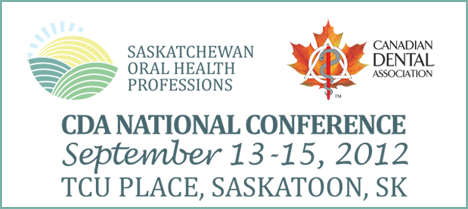A member service that keeps you up-to-date on important new literature relevant to your practice.

|
|
In this issue of JCDA Express our contributors highlight articles on direct pulp capping with calcium hydroxide, orofacial pain as a predictor of oral cancer, the effect of osseointegrated implant dentistry on tooth-supported crowns and fixed dental prostheses, and guidelines on antibiotic prophylaxis for infective endocarditis.
JCDA would like to gratefully acknowledge the publishers of these articles, who have granted free access to the full-text papers until November 3, 2011. Follow the links in the Notes and News sidebar to discover more about these publications.
CDA is currently seeking nominations for its annual awards and honours program. Perhaps you know a colleague that you feel deserves to be formally recognized by his or her peers. Visit the CDA Awards section for details on how to bring forward a worthy individual or organization for an award.
The University of Toronto's faculty of dentistry continuing dental education department is sponsoring a 1-day symposium on October 15 that will focus on treatment considerations for the elderly. My Editor's Blog features brief, narrated versions of upcoming presentations from some of the symposium speakers.
Follow jcda.ca on Twitter (@JCDATweets) to keep informed when new clinical and scientific material is posted to the site. Please tweet or send me an email with topics you would like to see covered in future editions of JCDA Express.
Yours sincerely,
Dr. John P. O'Keefe
Editor-in-chief
jokeefe@cda-adc.ca
|
|
|



|
|
|
Direct pulp capping with calcium hydroxide

Dr. Omar El-Mowafy is a professor of restorative dentistry in the department of clinical sciences at the University of Toronto faculty of dentistry. Dr. El-Mowafy recommends:
Willershausen B, Willershausen I, Ross A, Velikonja S, Kasaj A, Blettner M. Retrospective study on direct pulp capping with calcium hydroxide. Quintessence Int. 2011:42(2);165-71.
Full-text access to this article has expired.
JCDA Clinical Pearl: Amalgam had the best survival rate (84.2%) for pulp capping after a 9-year follow-up compared to resin composite/compomer (54.1%) and glass ionomer (51.5%).
Key points:
-
This clinical trial examined the success rate of pulp capping with calcium hydroxide over a period of 9 years.
-
The sample size was 1075 restorations placed in males (533) and females (542) of various age ranges in anterior and posterior teeth (175 incisors, 263 premolars and 637 molars).
-
The study was conducted in a university clinic in Germany, so dental students placed the majority of restorations (819) while the others were placed by dentists.
-
The procedure involved isolation with rubber dam, disinfecting the tooth with 3% hydrogen peroxide, application of soft calcium hydroxide followed by a “more solid” calcium hydroxide, then placement of a restoration of choice.
-
Restorative materials used were resin composite/compomer (41.7%), glass ionomer (38.3%), amalgam (14.9%), and other (5.1%).
-
Overall survival rate after 1 year was 80.1%. However, it dropped significantly after 9 years to 58.7%, with patient gender and type of tooth showing no significant difference on survival rates. Failures occurred more frequently in the older age groups, between ages 50 to 69.
-
After 9 years, survival rates were higher when the restorations were placed by dentists (62.7%) compared to those placed by students (56.5%).
-
The best survival rates for pulp capping after a 9-year follow-up were obtained with amalgam (84.2%), followed by resin composite/compomer (54.1%) and glass ionomer (51.5%).
Reasons for recommending this article:
The lengthy follow-up period (9 years) and large sample size (> 1000) of this study add significantly to its value, credibility and reliability. Similar studies are scarce or non-existent. Because the majority of restorations were placed by dental students, the long-term success rate of pulp capping might have been higher in the hands of more skilled operators. However, this study provides some answers to questions that dentists may have when making clinical decisions about what material or technique to use when dealing with pulp exposure, and what to tell patients about the expected outcome of such treatment.
|
|



|
|
|
Orofacial pain and oral cancer

Dr. Hagen B.E. Klieb is a staff oral pathologist at the Sunnybrook Health Sciences Centre, a University of Toronto-affiliated hospital, with cross appointments in the departments of dentistry and anatomic pathology. Dr. Klieb recommends:
Lam DK, Schmidt BL. Orofacial pain onset predicts transition to head and neck cancer. Pain. 2011:152(5);1206-9. Epub 2011 Mar 8.
Full-text access to this article has expired.
JCDA Clinical Pearl: The onset of orofacial pain may be an important predictor of the progression of oral precancer to cancer.
Key points:
-
This pilot study challenges the common belief that early head and neck cancer is painless.
- The authors performed a cross-sectional analysis on patients with biopsy-proven oral cancer (44), oral precancer/dysplasia (20) and normal oral mucosa (21).
-
Orofacial pain was assessed using a validated questionnaire.
-
The clinical presentation of early cancer was often indistinguishable from precancer, such as when it appeared as mixed red and white lesions (erythroleukoplakia).
-
Although pain levels in patients with oral precancer were not significantly different from pain levels in patients with normal oral mucosa, patients with oral cancer experienced significant spontaneous and function-related pain at the time of initial diagnosis.
Reasons for recommending this article:
As oral cancer progresses and grows, a mass lesion forms and local invasion and metastasis yield the characteristic features of malignancy (i.e., pain, hemorrhage, facial paresthesia, tooth mobility and lymphadenopathy). Unfortunately, late-stage presentation is common. This has often been attributed to the belief that early cancers are painless.
This pilot study suggests that the onset of orofacial pain may be an important predictor of the progression of oral precancer to cancer. Pain may be induced by tissue invasion and perhaps by the liberation of pain mediators by the tumour cells.
Although there are a myriad of causes for orofacial pain, recent onset of significant pain (particularly if exacerbated during function) should alert the clinician to perform a comprehensive visual and tactile examination of the oral mucosa.
In my own clinical practice, inconspicuous oral cancers have been identified in patients complaining of the onset of new or vague oral pain, otalgia and even pain in the temporomandibular joint region. Early recognition of the symptoms of cancer may facilitate detection at an early stage, which is the most effective means to reduce morbidity and mortality.
|
|



|
|
|
Survival rates of tooth-supported single crowns and FDPs

Dr. Brian Kucey is a clinical associate professor in the division of restorative dentistry at the University of Alberta. Dr. Kucey recommends:
Walton TR. Changes in the outcome of metal-ceramic tooth-supported single crowns and FDPs following the introduction of osseointegrated implant dentistry into a prosthodontic practice. Int J Prosthodont. 2009;22(3):260-7.
Full-text access to this article has expired.
JCDA Clinical Pearl : Structurally sound single teeth and short-span fixed partial dentures (3 units) can offer a reliable and predictable prognosis for the first 10-year period of service, similar to implant-retained prostheses.
Key points:
-
This prospective study analyzed the 10-year estimated survival rates of metal-ceramic tooth-supported single crowns and metal-ceramic tooth-supported fixed dental prostheses (FDPs) in patients treated by a single operator in a private practice setting.
-
The author compared prostheses cemented between 1989 and 1993, with the outcome determined in 1998 (group 1), versus prostheses cemented between 1997 and 2001, and examined in 2006 (group 2).
-
There was a 500% increase in the number of implants restored by the operator between the first and second time periods.
-
In group 2, the estimated cumulative 10-year survival rate was 90% for all FDPs and 97% for 3-unit FDPs.
-
In general, teeth in group 2 failed less through fracture and periodontal disease than those in group 1.
-
For specific teeth with single crowns, nonvital maxillary lateral and central incisors showed a strong trend for increased survival.
Reasons for recommending this article:
With the introduction of osseointegrated implant dentistry, the survival rates of tooth-supported single crowns and tooth-supported FDP abutments have improved, while failures of supporting teeth through fracture and periodontal disease have decreased. The trend to eliminate higher risk, long-span tooth-supported prostheses and to use more implant-supported prostheses has resulted in a higher overall clinical success rate.
The results of this study support the idea that teeth should be considered for extraction when they cannot be prepared with adequate retention and resistance form. However, the study also confirms that structurally sound nonvital teeth can be considered appropriate to support either tooth-supported single crowns or tooth-supported FDPs.
The improvement in survival rates and relatively low level of complication involved with traditional metal-ceramic tooth-supported prostheses is a reminder to dentists that this may be a viable treatment option. Of course, patient selection is crucial in any treatment plan, with long-term maintenance being key to a successful prognosis.
|
|

|
|
|
Antibiotic prophylaxis and infective endocarditis

Dr. Clive Schneider-Friedman is an adjunct professor in the division of orthodontics and pediatric dentistry at the Schulich School of Medicine and Dentistry, University of Western Ontario. Dr. Schneider-Friedman, a member of CDA's Committee on Clinical and Scientific Affairs, recommends:
Thornhill MH, Dayer MJ, Forde JM, Corey GR, Chu VH, Couper DJ, et al. Impact of the NICE guideline recommending cessation of antibiotic prophylaxis for prevention of infective endocarditis: before and after study. BMJ. 2011: May 3;342:d2392.
Full-text access to this article has expired.
JCDA Clinical Pearl: This study found no significant increase in cases of infective endocarditis, despite a large decrease in the prescribing of antibiotic prophylaxis.
Key points:
-
The National Institute for Health and Clinical Excellence (NICE) in the United Kingdom introduced new guidelines in March 2008, recommending the cessation of antibiotic prophylaxis for all patients at risk of infective endocarditis undergoing dental (or other) procedures.
-
Prior to these new guidelines, dental practitioners accounted for the vast majority (91.9%) of the overall prescriptions for antibiotic prophylaxis in the UK.
-
The current study examined national prescribing data and data recorded for all in-patient hospital activity in the UK, to try to quantify the effect of the NICE guideline on the prescribing of antibiotic prophylaxis and the incidence of infective endocarditis.
-
A large (78.6%) and rapid decrease occurred in the prescribing of antibiotic prophylaxis, from a mean 10 727 prescriptions per month before the 2008 guidelines, to 2292 per month after the guidelines.
-
In the 2 years after the guidelines were introduced, there was no significant increase in the number of cases of infective endocarditis, the rate of infective endocarditis related to deaths in hospital or the number of cases of infective endocarditis due to streptococci of possible oral origin.
-
This study had several limitations, including that it was a retrospective study and limited to patients in England; the data relied on hospital coding, which can be problematic (i.e., no requirements to record more than a primary diagnosis for a patient and no specific code for oral viridians group streptococci); although 35%–45% of cases of infective endocarditis may be caused by oral viridians group streptococci, good data are lacking on the proportion resulting from an invasive dental procedure.
Reasons for recommending this article:
The NICE guidelines differ slightly from recommendations in North America in that they no longer recommend antibiotic prophylaxis at all. The main rationale behind the NICE guidelines is that daily oral activities, such as chewing, tooth brushing and flossing, are more important causes of strep viridians-associated infective endocarditis. At a time when there is increasing focus on the need for better stewardship of the medical and dental profession with respect to antibiotic use, this article highlights a dramatic reduction of antibiotic use with no concomitant increase in endocarditis.
However, the evidence is still not conclusive on high-risk patients, such as those with prosthetic valves or who have undergone recent surgery. The evidence shows an increased risk of bacteremia after brushing in patients with poor oral hygiene and gingival disease. Therefore, improving oral health may be more effective in reducing the incidence of endocarditis.
The dental profession should continue to evaluate the evidence as it becomes available to improve our antibiotic stewardship.
|

|
|
|
|
|

JCDA is the authoritative written voice of the Canadian Dental Association, providing dialogue between the national association and the dental community. It is dedicated to publishing worthy scientific and clinical articles and informing dentists of issues significant to the profession.

|

|
NOTES AND NEWS
Check out the publications featured in this issue
Quintessence International
(publisher: Quintessence Publishing)
PAIN
(publisher: Elsevier)
The International Journal of Prosthodontics
(publisher: Quintessence Publishing)
BMJ
(publisher: BMJ Publishing Group)
|
CDA Awards Recognition Program – deadline October 7
CDA invites nominations for its 2011-12 Honours and Awards Program. Visit www.cda-adc.ca/en/cda/about_cda/awards/
|
Geriatric Dentistry: What Will Your Dental Practice Look Like in Ten Years?
October 15 in Toronto, ON
The University of Toronto is sponsoring a 1-day symposium on the treatment considerations for the elderly, with an emphasis on practical clinical procedures that can be implemented in the dental office. The symposium willfeature 8 national experts from the geriatric dentistry field. Visit
www.utcde.ca/course-pages-11-12/geriatric-dentistry.php
|
Search the JCDA Classified Ads
Looking for employment? Want to sell your practice? Classified ads offer the most effective way to reach all dentists and students in Canada.
|
Spread the word
Help spread the word about JCDA Express by telling your colleagues about it and reminding them to send CDA their email address.
reception@cda-adc.ca
|

|

|

|
|



